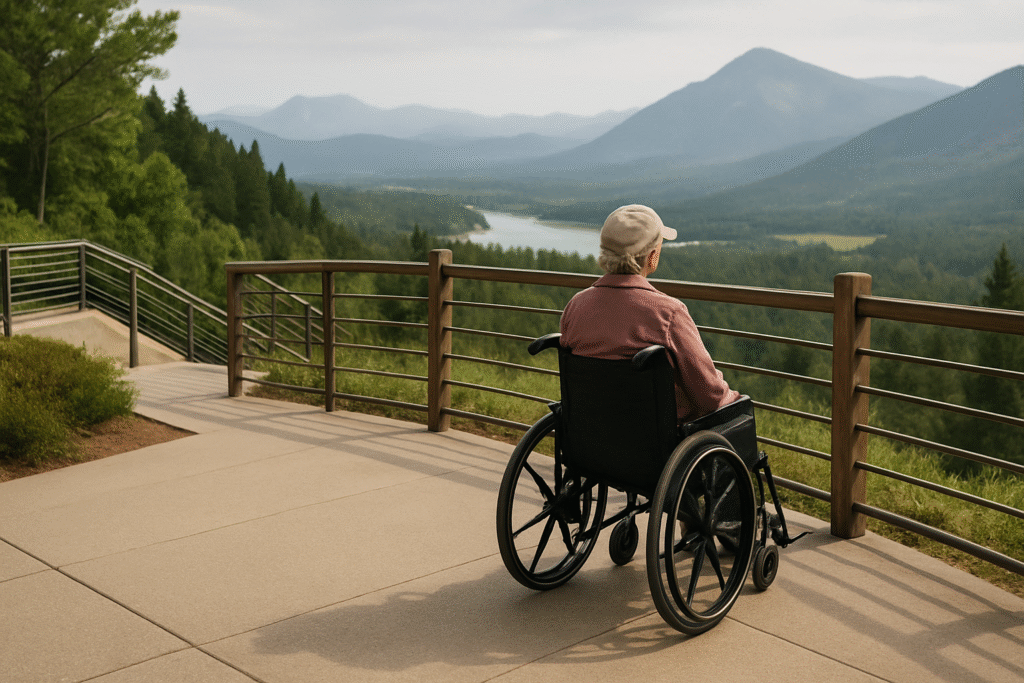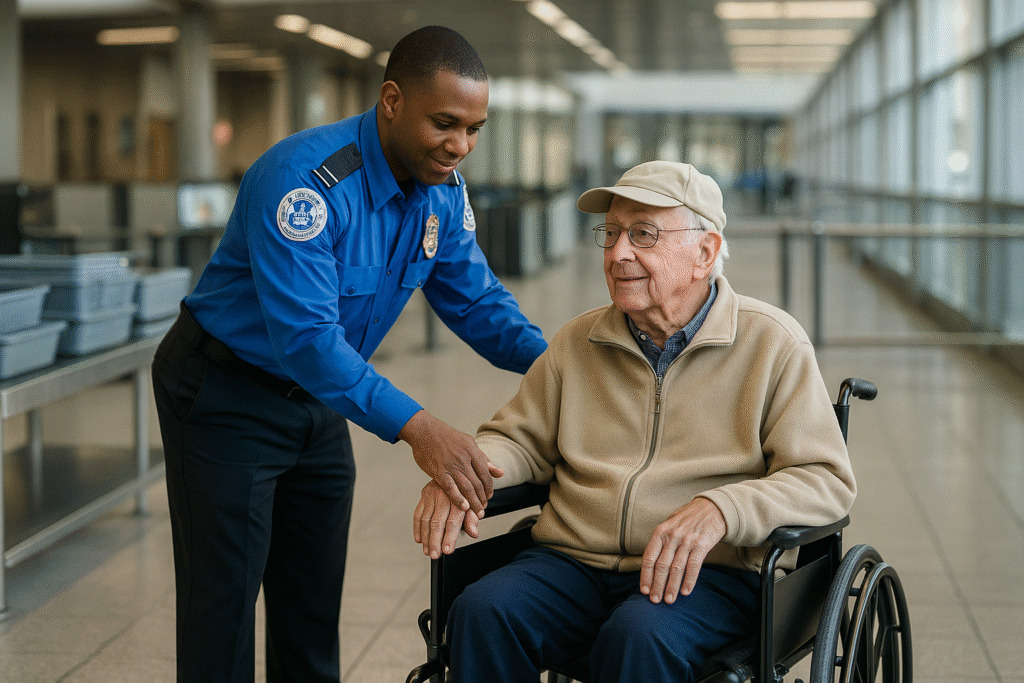
Affiliate Disclaimer: This post may contain affiliate links. If you purchase through these links, we may earn a small commission at no extra cost to you.
Introduction
Travel is one of life’s great joys, but for people who rely on wheelchairs, it can also feel overwhelming. From navigating airports to ensuring accessible hotel rooms, planning ahead makes all the difference. The good news: with the right preparation, traveling with a wheelchair is safer, easier, and more enjoyable than many expect.
As a wound care physician, I’ve seen firsthand how staying mobile and independent dramatically improves health and quality of life. Travel can boost confidence, reduce stress, and help people stay engaged with the world.
This 2025 guide shares 9 practical tips for traveling with a wheelchair, so seniors and caregivers can explore with confidence.
1. Plan Ahead with Accessibility in Mind
Accessibility varies widely between destinations, and even within the same city. Doing the research in advance helps prevent last-minute challenges and ensures a smoother experience. Always approach trip planning with accessibility as your top priority.
- Research your destination before booking. Look into transportation systems, restaurants, attractions, and public facilities to confirm accessibility.
- Use trusted accessibility resources. Sites like AccessibleGO allow wheelchair users to share firsthand reviews and experiences.
- Call hotels directly to confirm accommodations. Ask specific questions about roll-in showers, doorway widths, elevator access, and bed heights.
Pro tip: Don’t rely only on website descriptions — speaking with hotel staff gives the clearest picture.
Related guide: Tips for Making Your Home Safer for Seniors — the same bathroom features we recommend at home (grab bars, raised toilet seats, non-slip floors) are exactly what to look for when booking accessible hotel rooms.
2. Choose the Right Wheelchair for Travel
Not all wheelchairs are created equal when it comes to travel. The right choice depends on your needs, the type of trip, and how much lifting or folding may be required. Choosing wisely can make airport navigation and ground transportation significantly easier.
- Opt for lightweight manual chairs when possible. These are easier for caregivers to maneuver and for staff to store on planes.
- Consider foldable or travel power chairs. These models are designed to fit through tight spaces and fold for easy stowing.
- Bring portable ramps if needed. A simple travel ramp can help bridge small accessibility gaps in older buildings or outdoor areas.
Related guide: Best Lightweight Wheelchairs for Seniors
3. Know Airline Policies
Airlines have specific rules for passengers traveling with mobility aids, and understanding these in advance can prevent frustrating surprises. By being proactive and communicating with the airline early, you’ll avoid delays, reduce stress, and ensure your wheelchair is handled properly from check-in to arrival.
- Contact the disability desk as soon as tickets are booked. Most airlines have dedicated staff who can guide you through the process and note special requests in your reservation.
- Mobility devices are transported free of charge. U.S. carriers are legally required to check wheelchairs without fees under the Air Carrier Access Act.
- Ask about pre-boarding and accessible seating. Boarding first allows extra time for safe transfers and securing your wheelchair, while bulkhead or aisle seating can make travel more comfortable.
- Confirm power wheelchair requirements. Airlines need documentation about battery type, and some have restrictions on certain lithium-ion models. Submitting details early avoids last-minute issues.
Related guide: Best Mobility Scooters for Seniors — includes travel-friendly options and notes on airline policies.
4. Prepare for Airport Security

Airport security can be stressful, but knowing what to expect makes the process smoother. The TSA and airlines offer programs and support to ensure travelers with mobility needs are treated with respect and efficiency.
- Use the TSA Cares program for support. The TSA Cares program offers free passenger assistance — call 72 hours before flying to schedule help.
- Expect alternative screening methods. If you can’t transfer, you’ll likely receive a pat-down instead of passing through a scanner.
- Label your wheelchair clearly. Include your name, phone number, and destination address in case of separation.
- Pack a small toolkit for quick fixes. Tightening bolts or adjusting parts on the go can save frustration if your wheelchair is jostled during handling.
5. Protect Against Damage
Unfortunately, wheelchairs can sometimes be damaged during flights. Taking steps to protect your equipment ensures that even if something happens, you’re prepared to handle it quickly and effectively.
- Remove detachable parts before check-in. Cushions, joysticks, and side guards should be carried separately to avoid loss or breakage.
- Photograph your wheelchair before travel. Documenting its condition provides proof if you need to file a claim with the airline.
- Know where to get repairs. Research local wheelchair repair shops or service centers at your destination.
- Carry a small repair kit. Having tools on hand allows you to manage minor issues without waiting for professional help.
6. Pack Smart for Accessibility
Packing well can make the difference between a stressful trip and a smooth one. Focus on accessibility, organization, and comfort to ensure you’re ready for anything.
- Keep medications and essentials in your carry-on. Don’t risk losing them in checked luggage.
- Bring cushions or padding for long trips. This helps prevent pressure injuries and ensures comfort during extended sitting.
- Stay organized with packing cubes or labels. Clear organization reduces stress for both travelers and caregivers.
- Include wound care supplies if needed. As a wound care physician, I’ve seen the importance of having medical necessities on hand when traveling.
Related guide: Wheelchair Cushions for Comfort and Support
7. Book Accessible Transportation

Once you arrive, transportation is one of the most important pieces of the puzzle. Securing options ahead of time avoids last-minute stress and ensures you can get around safely.
- Reserve accessible vehicles in advance. Wheelchair-accessible taxis, vans, or shuttles should be booked before your trip.
- Leverage rideshare accessibility programs. Apps like UberWAV and Lyft Access are increasingly available in major cities.
- Explore medical transport services in smaller areas. In rural towns or less-developed regions, specialized services may be your most reliable option.
- Confirm vehicle specifications. Ensure the vehicle can accommodate your wheelchair’s size and weight.
8. Prioritize Comfort and Safety

Comfort and safety should guide every travel decision. From how long you sit to how often you hydrate, the little choices add up to a healthier, more enjoyable trip.
- Schedule rest breaks to avoid fatigue. Build downtime into your itinerary so you don’t feel rushed or exhausted.
- Use safety belts or positioning straps when available. These protect against falls and improve posture in moving vehicles.
- Stay hydrated throughout the trip. Dehydration increases fatigue and can worsen medical conditions.
- Shift weight regularly. Frequent movement helps prevent skin injuries and promotes circulation.
9. Stay Flexible and Patient
Even the best-laid travel plans sometimes go awry. Flexibility and patience not only reduce stress but also make the overall trip more enjoyable.
- Expect occasional delays or obstacles. Anticipating challenges makes them easier to handle when they arise.
- Keep a positive outlook. Your mindset plays a huge role in how you experience the trip.
- Remember the bigger picture. Travel is about creating memories, not letting small inconveniences steal your joy.
Final Thoughts
Travel is possible, rewarding, and liberating for wheelchair users. With thoughtful planning, the right equipment, and clear communication with airlines and hotels, trips can be safe and stress-free.
As a physician, I encourage patients and caregivers to embrace travel — it promotes independence, improves health, and brings joy. With these tips, your next trip can be less about logistics and more about adventure.
Frequently Asked Questions
Q1: Do airlines charge for wheelchairs?
No. U.S. airlines must transport wheelchairs free of charge under the Air Carrier Access Act.
Q2: What type of wheelchair is best for frequent travel?
Lightweight manual chairs or foldable power chairs are easiest to transport and less likely to be damaged during handling.
Q3: Can I take my power wheelchair on an airplane?
Yes, but airlines require documentation about your battery type. Some lithium-ion models are restricted, so confirm in advance.
Q4: How can I protect my wheelchair from damage during flights?
Remove detachable parts, photograph your chair before check-in, and bring a repair kit. Label your chair clearly with your contact information.
Q5: What travel programs support passengers with disabilities?
The TSA Cares program provides personalized assistance at airports, and most airlines have disability desks dedicated to handling accessibility needs.
Medical Disclaimer: This content is for informational purposes only and is not medical advice. Always consult a healthcare provider before traveling, especially if you have specific health needs or mobility challenges.
